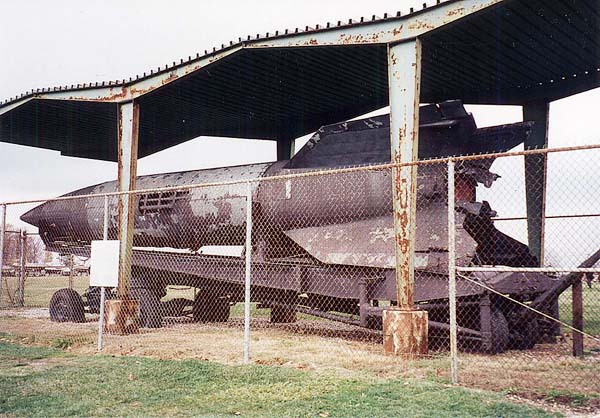
This is the example on display at the U.S. Army
Proving Grounds at
Aberdeen Maryland (as seen in 1998).
The V2 Tactical Ballistic Missile
(All photos by Phil Broad & Ed Whitefire
unless otherwise identified)
Web site by: Phil
Broad
The
V2 Exteriors:
Details of the V2 exterior from
different angles.
The
V2 Propulsion System:
The engine, pumps, thrust structure
and fuel tanks.
The
"Meillerwagen" Transporter & Erector:
The special transport trailer
which also served as the missile erector at the launch site.
The Mobile Launch Stand:
The small platform used for
missile alignment and support while being readied for firing.
Historical Photos:
Photographs taken during or
shortly after WWII.
So much has been written about the V2 and its development that I won't try to present a capsule history here. Suffice to say that, were it not for the development of the V2, no nation on Earth would have gone into space or to the moon until some time in the 21st century. Men first dreamed seriously about trips into space in the late 19th century and then wrote stories about those dreams. Those dreamers would go on to inspire the creative geniuses of the 20th century to attempt making the dreams a reality. Unfortunately the road to space was paved with warfare and hatred on a scale never before seen. The engineers and scientists involved would use their abilities to turn space technology into another tool of war, then try to claim no responsibility for such uses when the wars were over. History has yet to pass final judgment on these men, many of whom are still alive at the time of this writing but one thing is certain, after they entered the world it could never be the same again.
The V2 as a Weapon
The A4 (Aggregate 4), or "V2" as it would later be known, was a one-time use weapon which carried a one ton warhead. It was never perfected as a system but would see wide operational use during its brief career at the end of World War Two and was in a continuous state of development. Even as production missiles rolled out of the Mittlewerk near Nordhausen some examples were sent to development launch sites in Poland in an effort to solve its many remaining problems. By definition then, all surviving examples today represent the most advanced state of development achieved by German project engineers. V2 improvements then in the planning stages would later find their way into those rockets built by the Allied powers after the war. Improvements such as a separable warhead to increase range (by eliminating the mass of the spent booster assembly) or integral fuel tanks which eliminated the excess weight of an independent external skin. The full story of the V2 is still not known in its entirety and may never be but there were plans to use it for delivering weapons of mass destruction. Because of its extreme cost and limited "throw weight" (2,000 pounds) this may have been its only intended role but the warheads based on atomic physics never materialized. Much of this part of the V2 history remains classified to this day or has gone to the grave with the participants.
Please contact me if you have comments about these images or corrections to the information presented here via E-Mail.